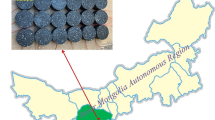Abstract
This article reports the acoustic emission (AE) study of precursory micro-cracking activity and fracture behaviour of quasi-brittle materials such as concrete and cement mortar. In the present study, notched three-point bend specimens (TPB) were tested under crack mouth opening displacement (CMOD) control at a rate of 0.0004 mm/sec and the accompanying AE were recorded using a 8 channel AE monitoring system. The various AE statistical parameters including AE event rate \( \left( {\frac{dn }{dt }} \right) \), AE energy release rate \( \left( {\frac{dE }{dt }} \right) \), amplitude distribution for computing the AE based b-value, cumulative energy (ΣE) and ring down count (RDC) were used for the analysis. The results show that the micro-cracks initiated and grew at an early stage in mortar in the pre peak regime. While in the case of concrete, the micro-crack growth occurred during the peak load regime. However, both concrete and mortar showed three distinct stages of micro-cracking activity, namely initiation, stable growth and nucleation prior to the final failure. The AE statistical behavior of each individual stage is dependent on the number and size distribution of micro-cracks. The results obtained in the laboratory are useful to understand the various stages of micro-cracking activity during the fracture process in quasi-brittle materials such as concrete & mortar and extend them for field applications.















Similar content being viewed by others
References
Karihaloo BL (1995) Fracture mechanics and structural concrete. Addison, Wesley Longman, UK
Bazant ZP, Planas J (1998) Fracture and size effect in concrete and other quasi-brittle materials. CRC Press, Roca Baton
Shah SP, Swartz SE, Ouyang C (1995) Fracture mechanics of concrete: applications of fracture mechanics to concrete, rock and other quasi-brittle materials. John Wiley & Sons Inc., New York
van Mier JGM (1997) Fracture process of concrete: Assessment of material parameters for fracture models. CRC press, Boca Raton, FL
Maji A, Shah SP (1988) Process zone and acoustic-emission measurements in concrete. Exp Mech 28:27–34
Shah SG, Chadrakishen JM (2011) Fracture properties of concrete-concrete interface using digital image correlation. Exp Mech 51:303–313
Farhang AA (2005) The influence of positive temperature gradient on fracture energy of concrete, Proceedings of the workshop on fracture mechanics for concrete pavements: theory to practice, Copper Mountain, Colorado USA, 10-12 Aug 2005, preceding the 8th international conference on concrete pavements
Grosse CU, Ohtsu M (2008) Acoustic emission testing. Springer-Verlag, Berlin Heidelberg
Vidya Sagar R, Raghu Prasad BK (2012) A review of recent development in parametric based acoustic emission techniques applied to concrete structures. Nondestruct Test Eval 27(1):47–68
Ohtsu M (1996) The history and development of acoustic emission in concrete engineering. Mag Concr Res 48(147):321–330
Colombo S, Main IG, Forde MC (2003) Assessing damage of reinforced concrete beam using b-value analysis of acoustic emission signals. ASCE J Mat Civ Eng 5(6):280–286
Rao MVMS, Prasanna Lakshmi KJ, Nagaraja Rao GM, Vijayakumar K, Udayakumar S (2011) Precursory microcracking and brittle failure of Latur basalt and migmatite gneiss under compressive loading. Curr Sci 101(8):1053–1059
Scholz CH (1968) The frequency–magnitude relation of microcracking in rock and its relation to earthquakes. Bull Seismol Soc Am 58:399–415
Lockner D (1993) The role of acoustic emission in the study of rock fracture. Int J Rock Mech Min Sci Geomech Abstr 30:883–899
Recommendation of RILEM TC 212-ACD: acoustic emission and related NDE techniques for crack detection and damage evaluation in concrete. Measurement method for acoustic emission signals in concrete. Mat Str 43:1177–1181
Main IG, Meredith PG, Jones C (1989) A reinterpretation of the precursory seismic b-value anomaly from fracture mechanics. Geophys J 96:131–138
Schumacher T, Higgins CC, Lovejoy SC (2011) Estimating operating load conditions on reinforced concrete highway bridges with b-value analysis from acoustic emission monitoring. Struct Health Monit 10(1):17–32
Rao MVMS, Prasanna Lakshmi KJ (2005) Analysis of b-value and improved b-value of acoustic emissions accompanying rock fracture. Curr Sci 89:1577–1582
Carpinteri A, Lacidogna G, Manuello A (2011) The b-value analysis for the stability investigation of the ancient Athena Temple in Syracuse. Strain 47(Suppl):243–253
Carpinteri A, Lacidogna G (2003) Damage diagnostic in concrete and masonry structures by acoustic emission technique, Facta universities. Ser Mech Autom Control Robot 3:55–764
Carpinteri A, Xu J, Lacidogna G, Manuello A (2012) Reliable onset time determination and source location of acoustic emissions in concrete structures. Cem Concr Compos 34:529–537
Lacidogna G, Carpinteri A, Manuello A, Durin G, Schiavi A, Niccolini G, Agosto A (2011) Acoustic and electromagnetic emissions as precursor phenomena in failure processes. Strain 47(2):144–152
Schiavi A, Niccolini G, Tarizzo P, Carpinteri A, Lacidogna G, Manuello A (2011) Acoustic emissions at high and low frequencies during compression tests of brittle materials. Strain 47(2):105–110
Carpinteri A, Lacidogna G, Puzzi S (2008) Prediction of cracking evolution in full scale structures by the b-value analysis and Yule statistics. Phys Mesomech 11(5–6):260–271
Carpinteri A, Lacidogna G, Manuello A (2007) Damage mechanisms interpreted by acoustic emission signal analysis. Key Eng Mater 347:577–582
Kurz JH, Finck F, Grosse CU, Reinhardt HW (2006) Stress drop and stress redistribution in concrete quantified over time by the b-value analysis. Struct Health Monit 5:69–81
Landis EN, Baillon L (2002) Experiments to relate acoustic emission energy to fracture energy of concrete. J Eng Mech (ASCE) 128:698–702
RILEM draft recommendations (1991) TC-89 FMT fracture mechanics of concrete – test methods. Mater Struct 23:461–465
Physical Acoustic Corporation (PAC) (2005) SAMOS AE system User’s manual Rev. 2 May 2005, NJ USA
Author information
Authors and Affiliations
Corresponding author
Rights and permissions
About this article
Cite this article
Vidya Sagar, R., Prasad, R.V., Raghu Prasad, B.K. et al. Microcracking and Fracture Process in Cement Mortar and Concrete: A Comparative Study Using Acoustic Emission Technique. Exp Mech 53, 1161–1175 (2013). https://doi.org/10.1007/s11340-012-9708-z
Received:
Accepted:
Published:
Issue Date:
DOI: https://doi.org/10.1007/s11340-012-9708-z




